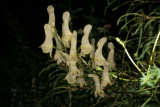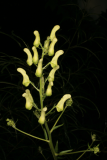Additional notes (click to expand)
Commemorative
Named for the Frenchman, Jean Baptiste Lamarck (1744–1829), a failed medical student, in our list of Doctors in the Medicinal Garden. Aconitum lamarckii was named after him, but the name is disappearing in favour of Aconitum lycoctonum subsp neapolitanum, which is the name we now use.
He was born Jean Baptiste Pierre Antoine de Monet, Chevalier de Lamarck, in Picardy, France. As the 11th child of the impoverished lord of the manor, he started his higher education in a Jesuit College with the aim of entering the church. Three of his brothers were in the army, and he gave up his studies and joined the army at the age of 17. He survived the massacre of all but 14 of his company in the battle of Fissinghausen (1761), taking command when all the officers were killed, and on being relieved received a battlefield commission. Later, when in barracks at Toulon and Monaco, his neck was damaged during some horseplay and this forced him to resign. He studied medicine for four years but could not afford to complete his studies, so became a botanist. He published a simple dichotomous key to the French flora, Flore francoise (1778), in three volumes. Lamarck was appointed a royal botanist in 1779, travelling and collecting specimens and, on his
return, commenced the publication of his 10-volume Encyclopédie méthodique botanique (1783–1823), which contained illustrations of 2,000 genera on 1,000 plates. His enthusiasm was immense, and when the naturalist and explorer Pierre Sonnerat (1748–1814) returned from India with a large herbarium, Lamarck was the only person to visit him – an act which was rewarded by the gift of Sonnerat’s herbarium. He also acquired the herbarium of Dr Philibert Commerson (1727–73), the French physician and naturalist, who accompanied Louis de Bougainville on the latter’s circumnavigation of the world (1766–9). In 1788, he became keeper of the herbarium at the Royal Garden The French Revolution ended royal patronage and in 1793 he lost his botanical post. In the reappointment process (familiar to us today when there is a management change and all the employees have to apply for their own jobs) at the re-named Museum of Natural History in Paris, he was appointed professor of invertebrate zoology – a subject about which he knew nothing. He clearly worked hard, for his Histoire naturelle des animaux sans vertébres (Natural history of invertebrates, 7 vols, 1815–22) was highly acclaimed. However, he propounded a theory of evolution (inheritance of acquired characteristics) and many incomprehensible ideas based on spontaneous generation of animals, the interactions of the four elements of Ancient Greece (earth, air, fire and water) which owed everything to the traditions of alchemy and nothing to the advances
in chemistry and physics, which he rejected, and published ludicrous forecasts of daily temperatures for 11 years in advance, until publicly and brutally mocked by Napoleon.
Oakeley, Dr. Henry. (2012). Doctors in the Medicinal Garden. Plants named after physicians. Royal College of Physicians.
link
His concepts of evolution have been summarised by Georges Cuvier (1836) as follows:
It is the desire and the attempt to swim that produces membranes in the feet of aquatic birds; wading in the water, and at the same time the desire to avoid wet, has lengthened the legs of such as frequent the sides of rivers; and it is the desire of fl ying that has converted the arms of all birds into wings, and their hairs and scales into feathers. He published his theories in Recherches sur les causes des principaux faits physiques (Research on the causes of the principal physical facts, 1794) and Memoires de physique et d’histoire naturelle (Memoirs on physics and natural history, 1797), which were so obviously weird that no one took any notice of them. That his theory of inheritance
of acquired characteristics should still be taught and have its adherents, can only be regarded as strange, but we are fortunate that his ideas of spontaneous generation of lower plants and animals (and the geology of the planet) have (one hopes) completely disappeared. Blindness and poverty blighted his final years, but in recognition of his now forgotten monumental works of botany and invertebrate zoology, over 100 species of plants (including the small, spring-flowering tree, Amelanchier lamarckii, in the North American bed) and 100 marine species have been named after him (Cuvier, 1836).
Oakeley, Dr. Henry. (2012). Doctors in the Medicinal Garden. Plants named after physicians. Royal College of Physicians.
link
Medicinal
Banned.
Nomenclature
Syn. of Aconitum lycoctonum subsp. neopolitanum
The Royal Horticultural Society Horticultural Database, available at www.rhs.org.uk
Phytochemistry
Active Principle: All parts es[pecially tubers: Aconitine, mesaconitine, lycoctonine and other terpene alkaloids (up to 2% in tubers).
Wink, M. (2009). Mode of Action and toxicology of plant toxins and poisonous plants. Mitt. Julius Kuhn-Inst. 421:93-111.
Toxicity
Toxicity 1a: extremely hazardous. Aconitine activates Na+ channels and is thus a strong nerve and muscle poison, causes numbness, causes paralysis.
Wink, M. (2009). Mode of Action and toxicology of plant toxins and poisonous plants. Mitt. Julius Kuhn-Inst. 421:93-111.
Geographical distribution
- Europe
Aconitum lamarckii Rchb.
Family: RANUNCULACEAEGenus: Aconitum
Species: lamarckii Rchb.
Common names: Lamark's Aconite
Distribution summary: S.Europe
Habit: Perennial
Hardiness: H5 - Hardy; cold winter
Garden status: Currently grown
Garden location: Europe & Middle East (J)
Reason for growing: Commemorative, toxic


